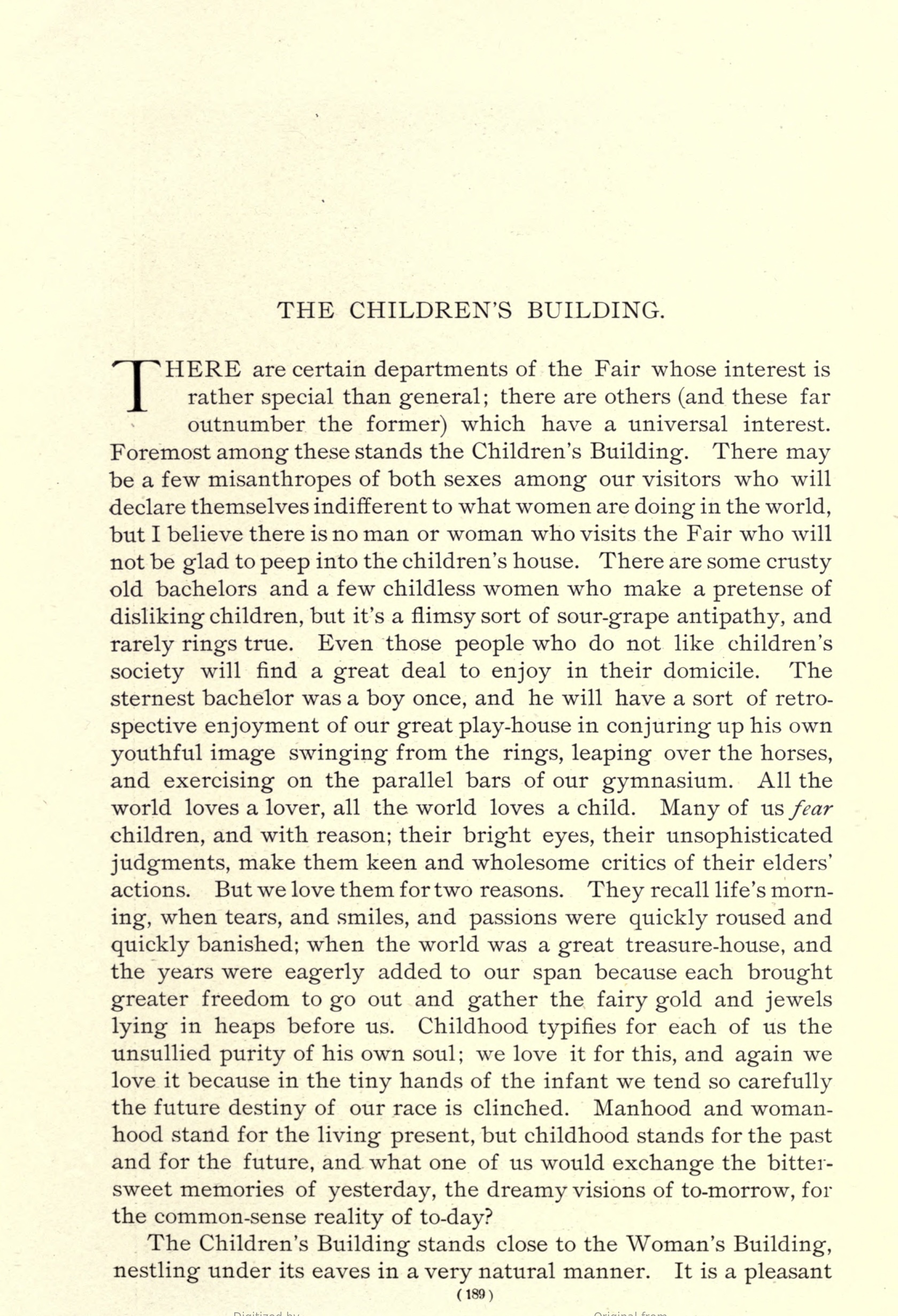
THE CHILDREN'S BUILDING.
THERE are certain departments of the Fair whose interest is rather special than general; there are others (and these far outnumber the former) which have a universal interest. Foremost among these stands the Children's Building. There may be a few misanthropes of both sexes among our visitors who will declare themselves indifferent to what women are doing in the world, but I believe there is no man or woman who visits the Fair who will not be glad to peep into the children's house. There are some crusty old bachelors and a few childless women who make a pretense of disliking children, but it's a flimsy sort of sour-grape antipathy, and rarely rings true. Even those people who do not like children's society will find a great deal to enjoy in their domicile. The sternest bachelor was a boy once, and he will have a sort of retrospective enjoyment of our great play-house in conjuring up his own youthful image swinging from the rings, leaping over the horses, and exercising on the parallel bars of our gymnasium. All the world loves a lover, all the world loves a child. Many of us fear children, and with reason; their bright eyes, their unsophisticated judgments, make them keen and wholesome critics of their elders' actions. But we love them for two reasons. They recall life's morning, when tears, and smiles, and passions were quickly roused and quickly banished; when the world was a great treasure-house, and the years were eagerly added to our span because each brought greater freedom to go out and gather the fairy gold and jewels lying in heaps before us. Childhood typifies for each of us the unsullied purity of his own soul; we love it for this, and again we love it because in the tiny hands of the infant we tend so carefully the future destiny of our race is clinched. Manhood and womanhood stand for the living present, but childhood stands for the past and for the future, and what one of us would exchange the bittersweet memories of yesterday, the dreamy visions of to-morrow, for the common-sense reality of to-day?
The Children's Building stands close to the Woman's Building, nestling under its eaves in a very natural manner. It is a pleasant
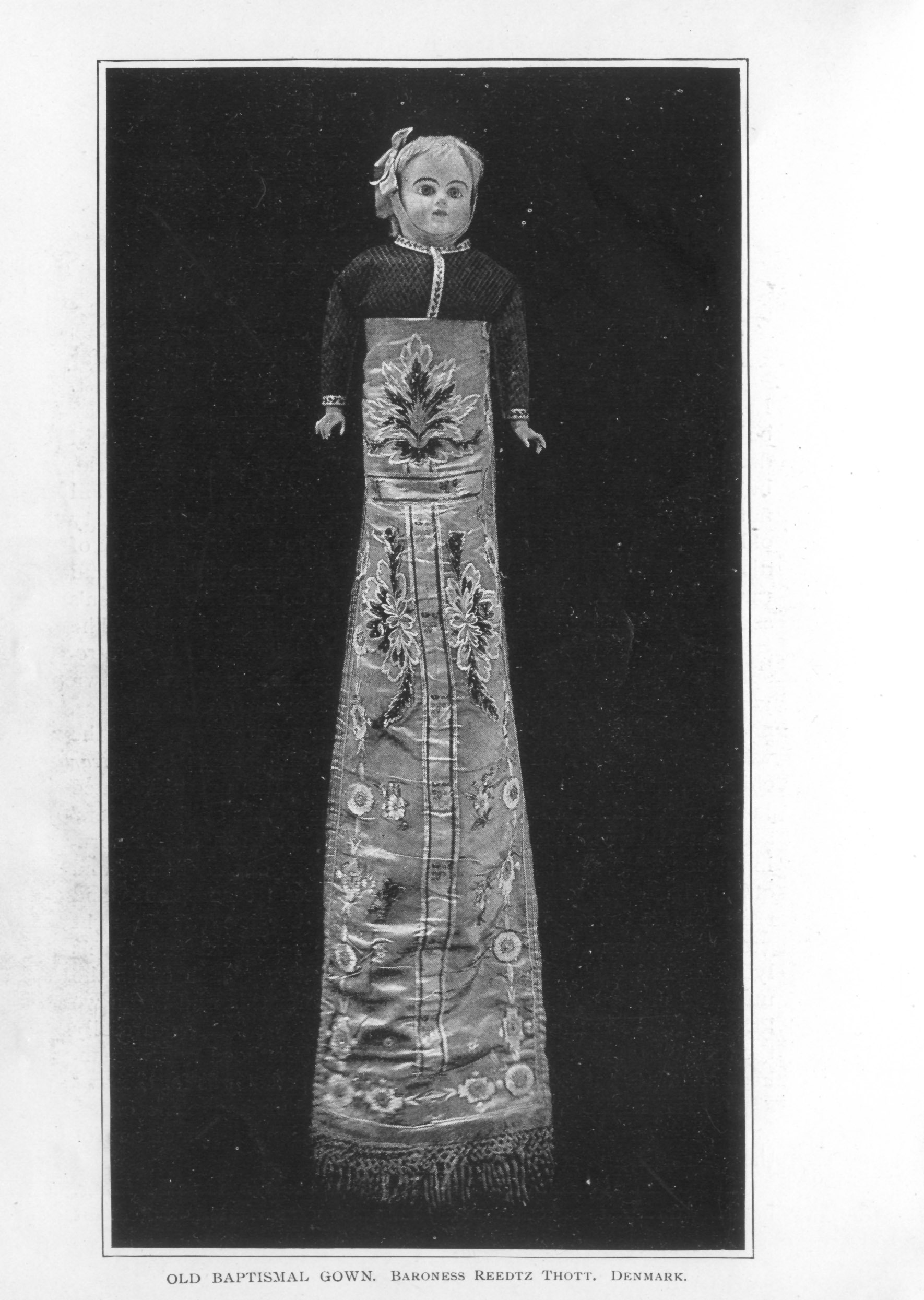
OLD BAPTISMAL GOWN.
BARONESS REEDTZ THOTT.
DENMARK.
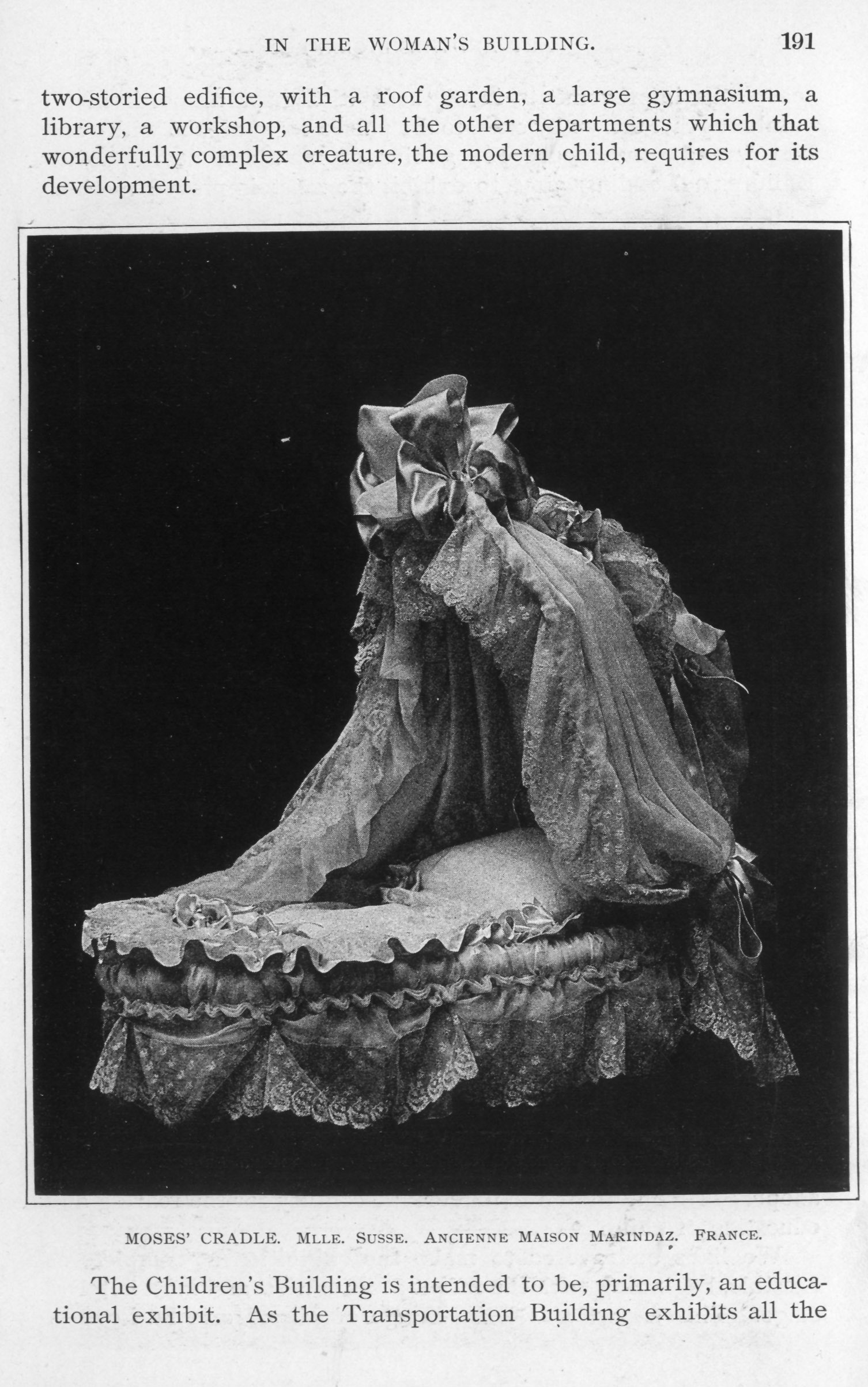
MOSES' CRADLE.
MLLE. SUSSE. ANCIENNE MAISON MARINDAZ. FRANCE.
two-storied edifice, with a roof garden, a large gymnasium, a library, a workshop, and all the other departments which that wonderfully complex creature, the modern child, requires for its development.
The Children's Building is intended to be, primarily, an educational exhibit. As the Transportation Building exhibits all the
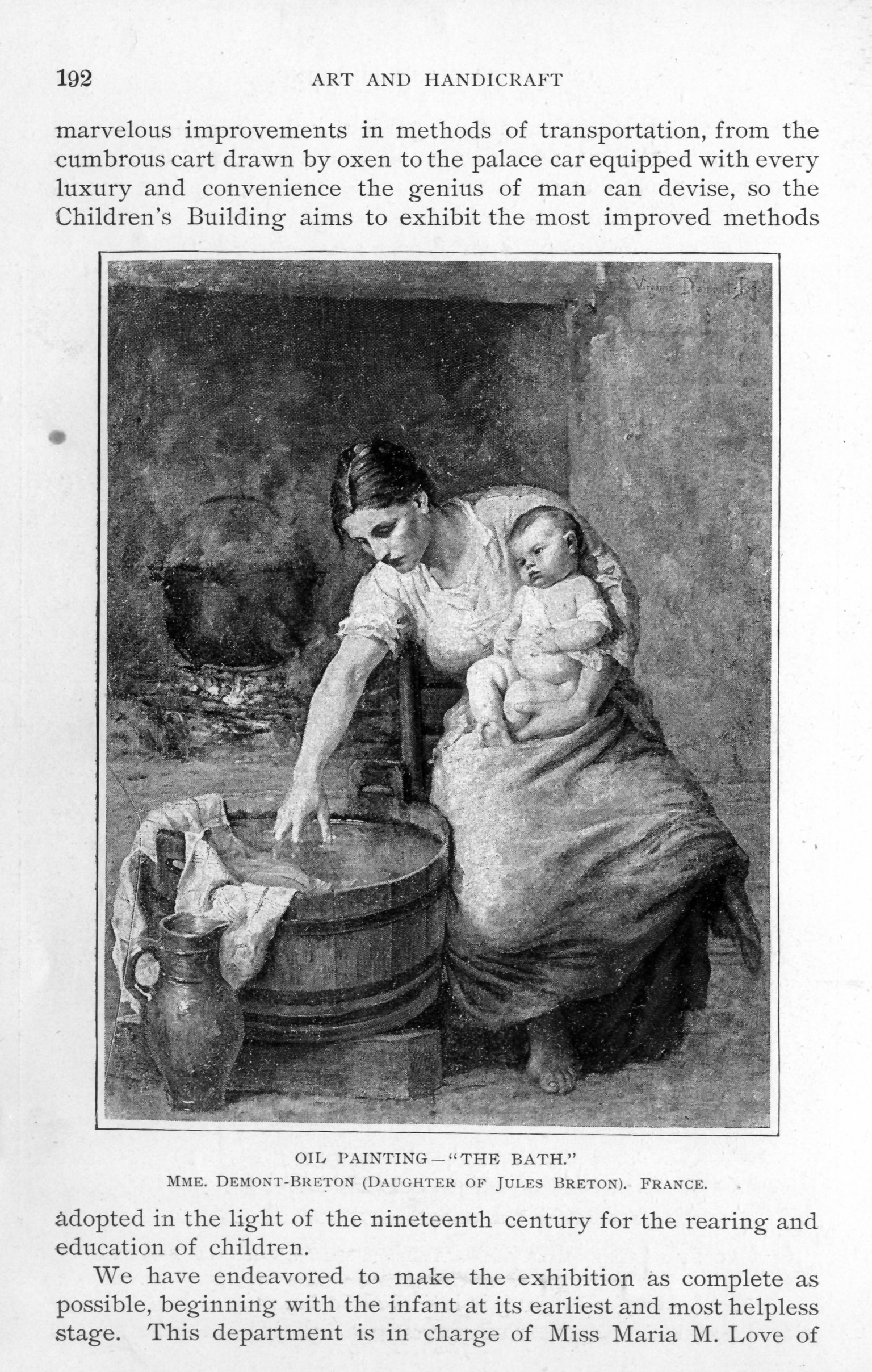
OIL PAINTING—"THE BATH."
MME. DEMONT-BRETON (DAUGHTER OF JULES BRETON). FRANCE.
marvelous improvements in methods of transportation, from the cumbrous cart drawn by oxen to the palace car equipped with every luxury and convenience the genius of man can devise, so the Children's Building aims to exhibit the most improved methods adopted in the light of the nineteenth century for the rearing and education of children.
We have endeavored to make the exhibition as complete as possible, beginning with the infant at its earliest and most helpless stage. This department is in charge of Miss Maria M. Love of
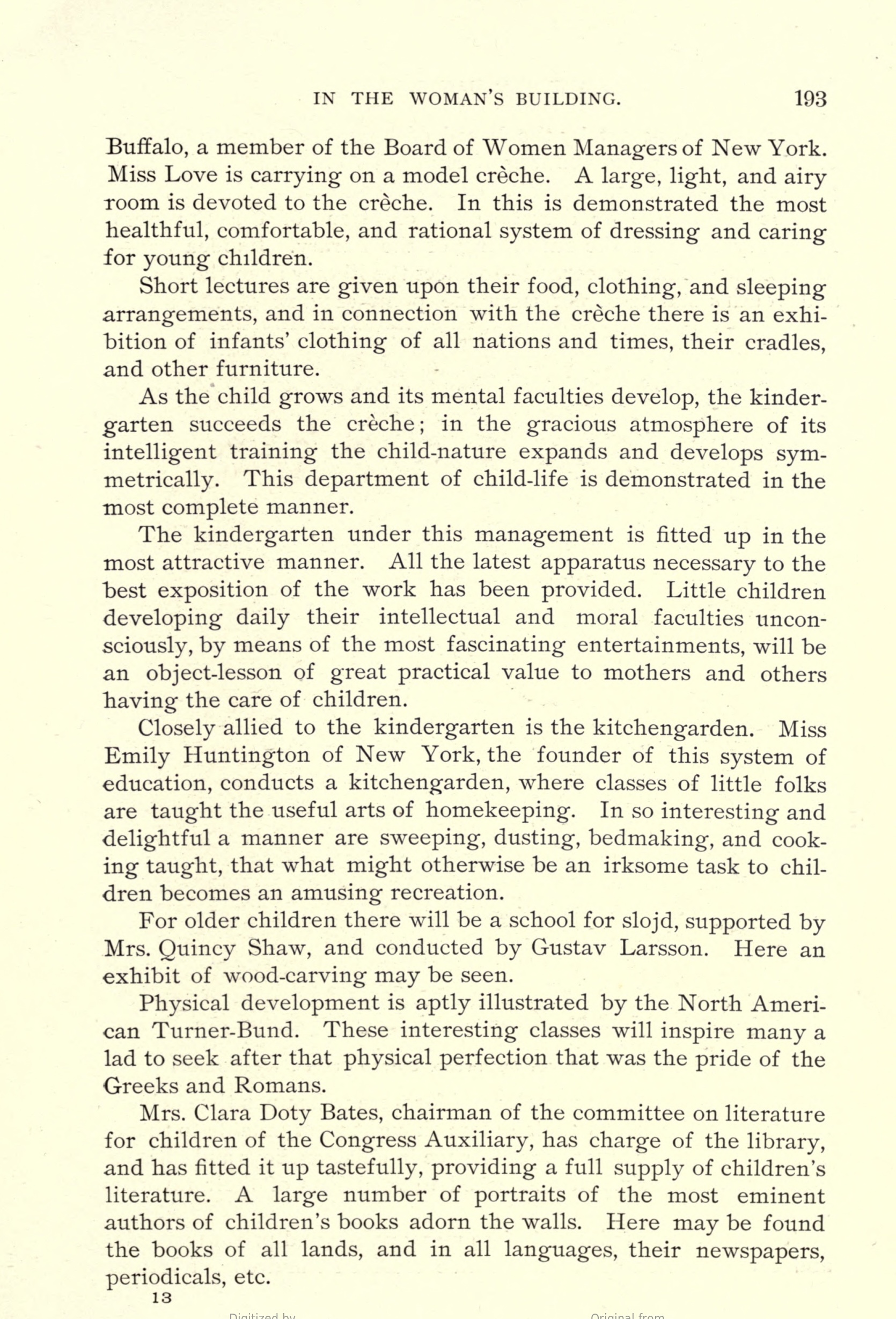
Buffalo, a member of the Board of Women Managers of New York. Miss Love is carrying on a model crèche. A large, light, and airy room is devoted to the crèche. In this is demonstrated the most healthful, comfortable, and rational system of dressing and caring for young children.
Short lectures are given upon their food, clothing, and sleeping arrangements, and in connection with the crèche there is an exhibition of infants' clothing of all nations and times, their cradles, and other furniture.
As the child grows and its mental faculties develop, the kindergarten succeeds the crèche; in the gracious atmosphere of its intelligent training the child-nature expands and develops symmetrically. This department of child-life is demonstrated in the most complete manner.
The kindergarten under this management is fitted up in the most attractive manner. All the latest apparatus necessary to the best exposition of the work has been provided. Little children developing daily their intellectual and moral faculties unconsciously, by means of the most fascinating entertainments, will be an object-lesson of great practical value to mothers and others having the care of children.
Closely allied to the kindergarten is the kitchengarden. Miss Emily Huntington of New York, the founder of this system of education, conducts a kitchengarden, where classes of little folks are taught the useful arts of homekeeping. In so interesting and delightful a manner are sweeping, dusting, bedmaking, and cooking taught, that what might otherwise be an irksome task to children becomes an amusing recreation.
For older children there will be a school for slojd, supported by Mrs. Quincy Shaw, and conducted by Gustav Larsson. Here an exhibit of wood-carving may be seen.
Physical development is aptly illustrated by the North American Turner-Bund. These interesting classes will inspire many a lad to seek after that physical perfection that was the pride of the Greeks and Romans.
Mrs. Clara Doty Bates, chairman of the committee on literature for children of the Congress Auxiliary, has charge of the library, and has fitted it up tastefully, providing a full supply of children's literature. A large number of portraits of the most eminent authors of children's books adorn the walls. Here may be found the books of all lands, and in all languages, their newspapers, periodicals, etc.
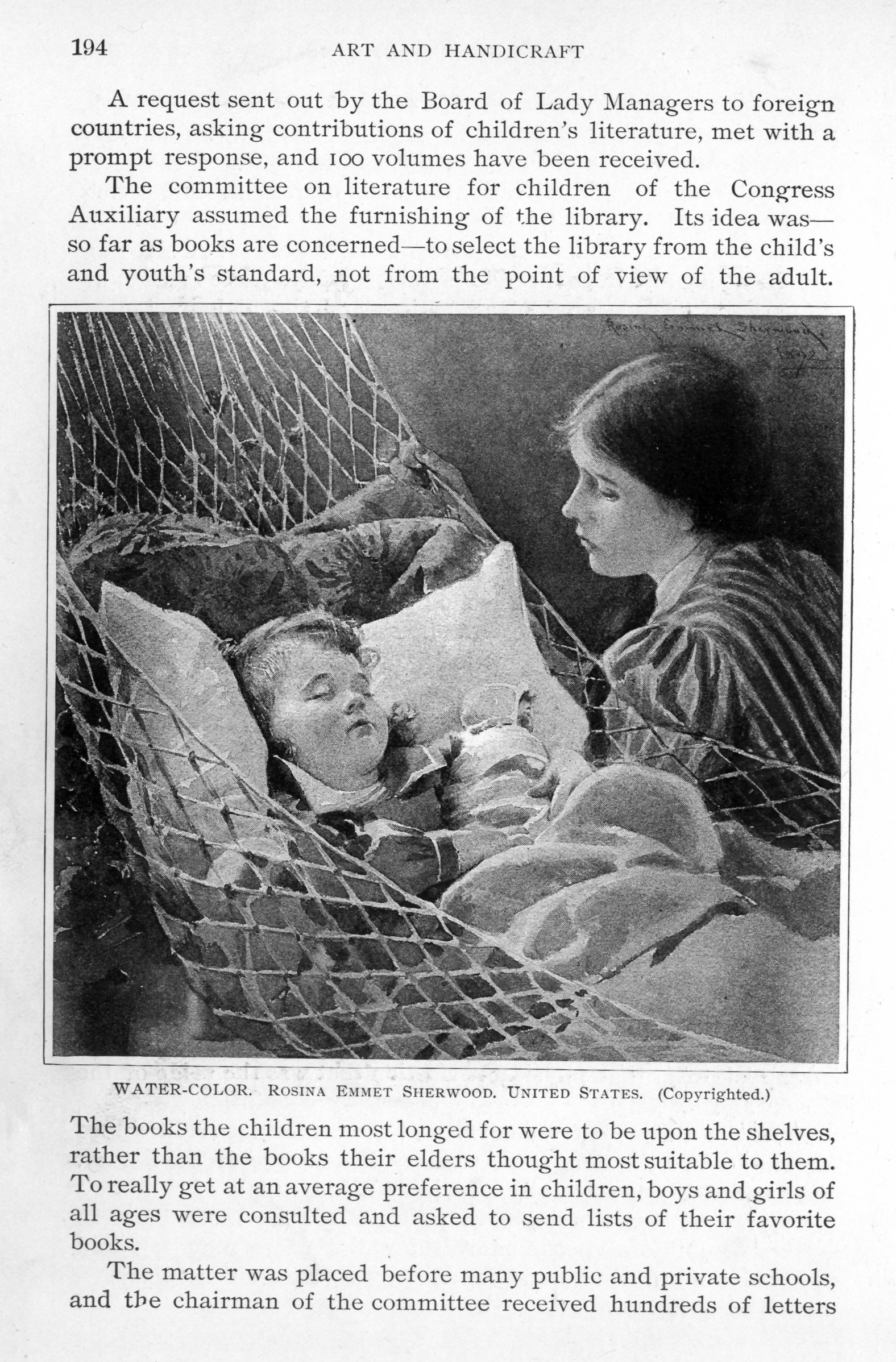
WATER-COLOR.
ROSINA EMMET SHERWOOD.
UNITED STATES. (Copyrighted.)
A request sent out by the Board of Lady Managers to foreign countries, asking contributions of children's literature, met with a prompt response, and 100 volumes have been received.
The committee on literature for children of the Congress Auxiliary assumed the furnishing of the library. Its idea was—so far as books are concerned—to select the library from the child's and youth's standard, not from the point of view of the adult. The books the children most longed for were to be upon the shelves, rather than the books their elders thought most suitable to them. To really get at an average preference in children, boys and girls of all ages were consulted and asked to send lists of their favorite books.
The matter was placed before many public and private schools, and the chairman of the committee received hundreds of letters
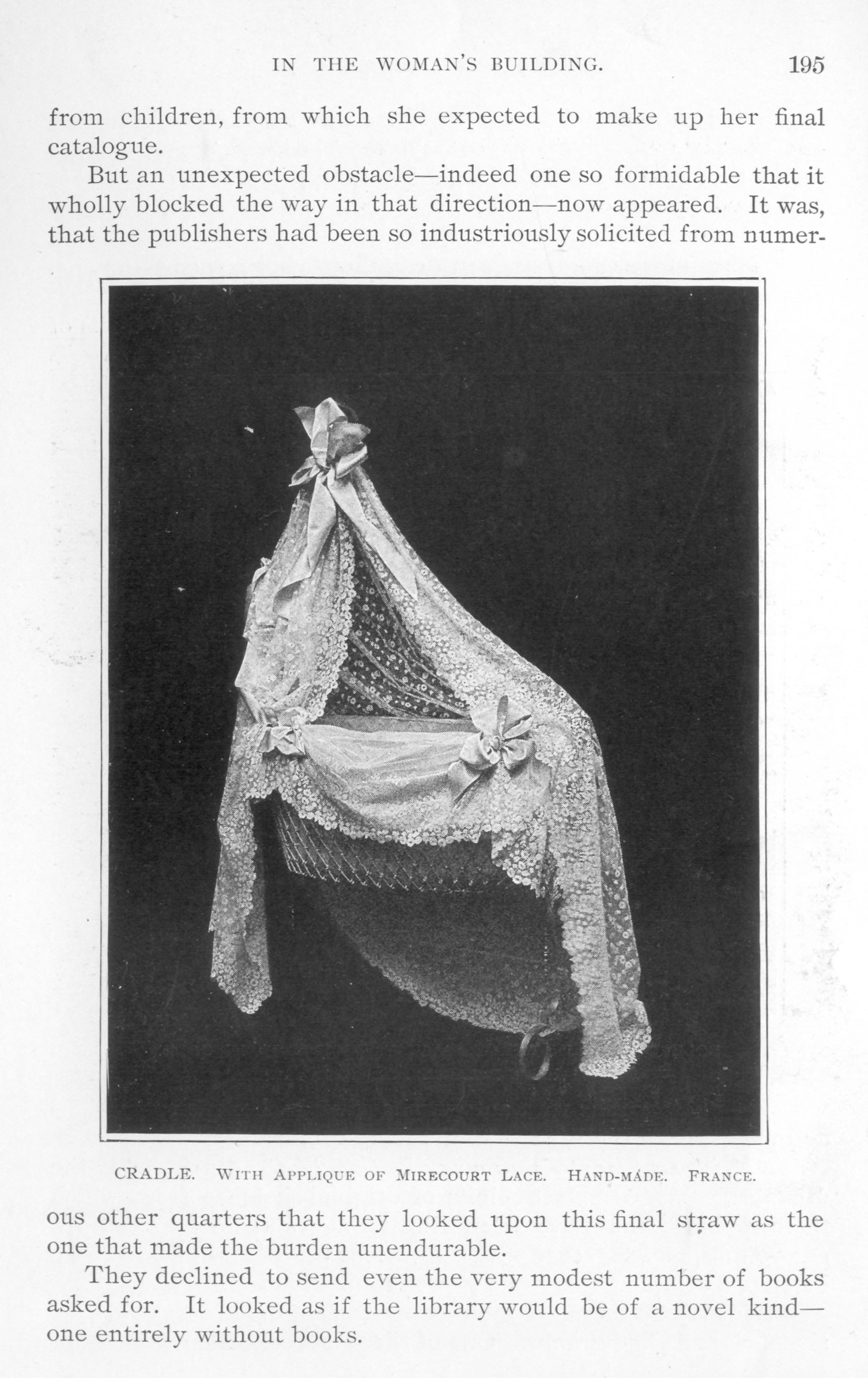
CRADLE. WITH APPLIQUE OF MIRECOURT LACE. HAND-MADE. FRANCE.
from children, from which she expected to make up her final catalogue.
But an unexpected obstacle—indeed one so formidable that it wholly blocked the way in that direction—now appeared. It was, that the publishers had been so industriously solicited from numerous other quarters that they looked upon this final straw as the one that made the burden unendurable.
They declined to send even the very modest number of books asked for. It looked as if the library would be of a novel kind—one entirely without books.
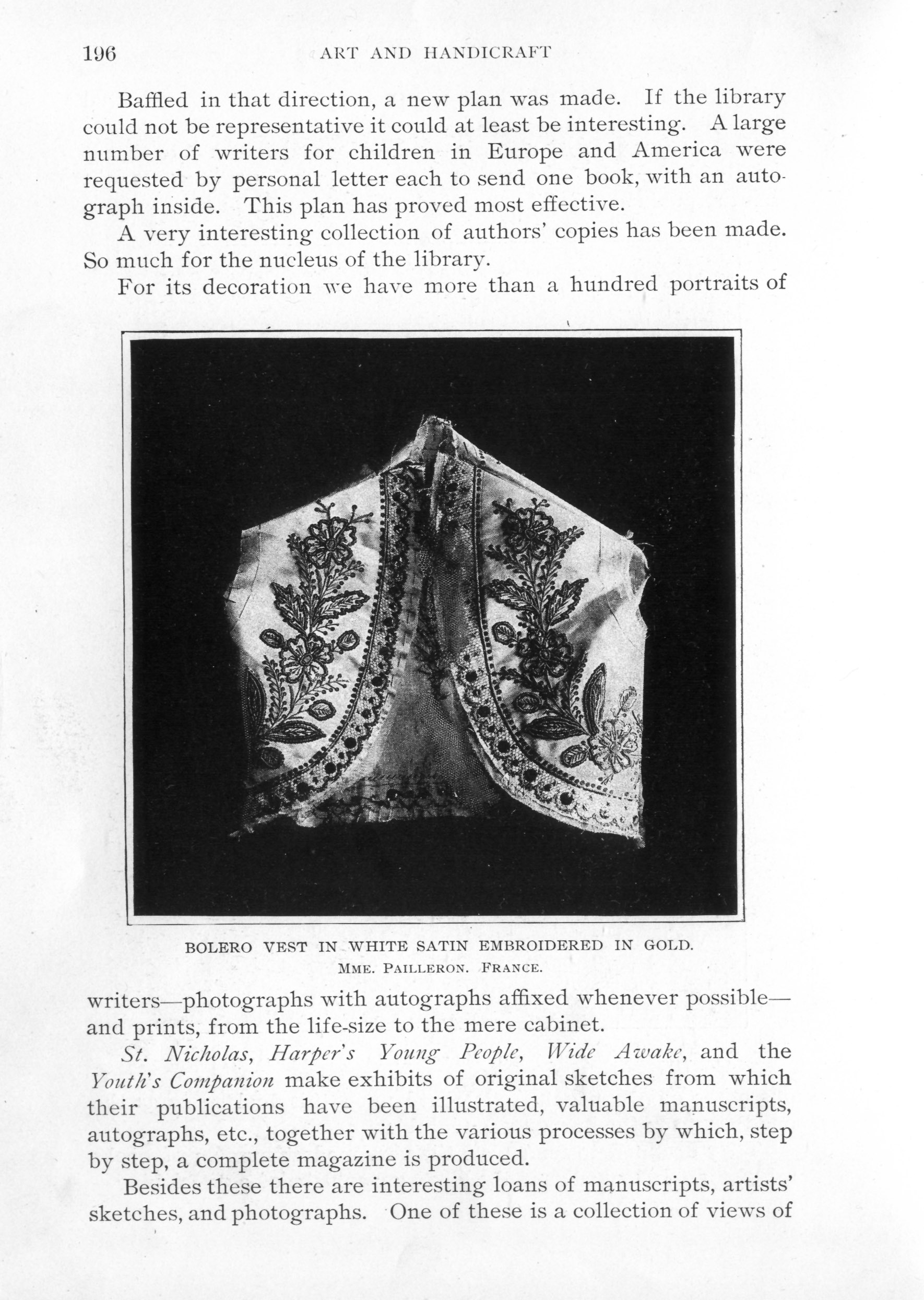
BOLERO VEST IN WHITE SATIN EMBROIDERED IN GOLD.
MME. PAILLERON. FRANCE.
Baffled in that direction, a new plan was made. If the library could not be representative it could at least be interesting. A large number of writers for children in Europe and America were requested by personal letter each to send one book, with an autograph inside. This plan has proved most effective.
A very interesting collection of authors' copies has been made. So much for the nucleus of the library.
For its decoration we have more than a hundred portraits of writers—photographs with autographs affixed whenever possible—and prints, from the life-size to the mere cabinet.
St. Nicholas, Harper's Young People, Wide Awake, and the Youth's Companion make exhibits of original sketches from which their publications have been illustrated, valuable manuscripts, autographs, etc., together with the various processes by which, step by step, a complete magazine is produced.
Besides these there are interesting loans of manuscripts, artists' sketches, and photographs. One of these is a collection of views of
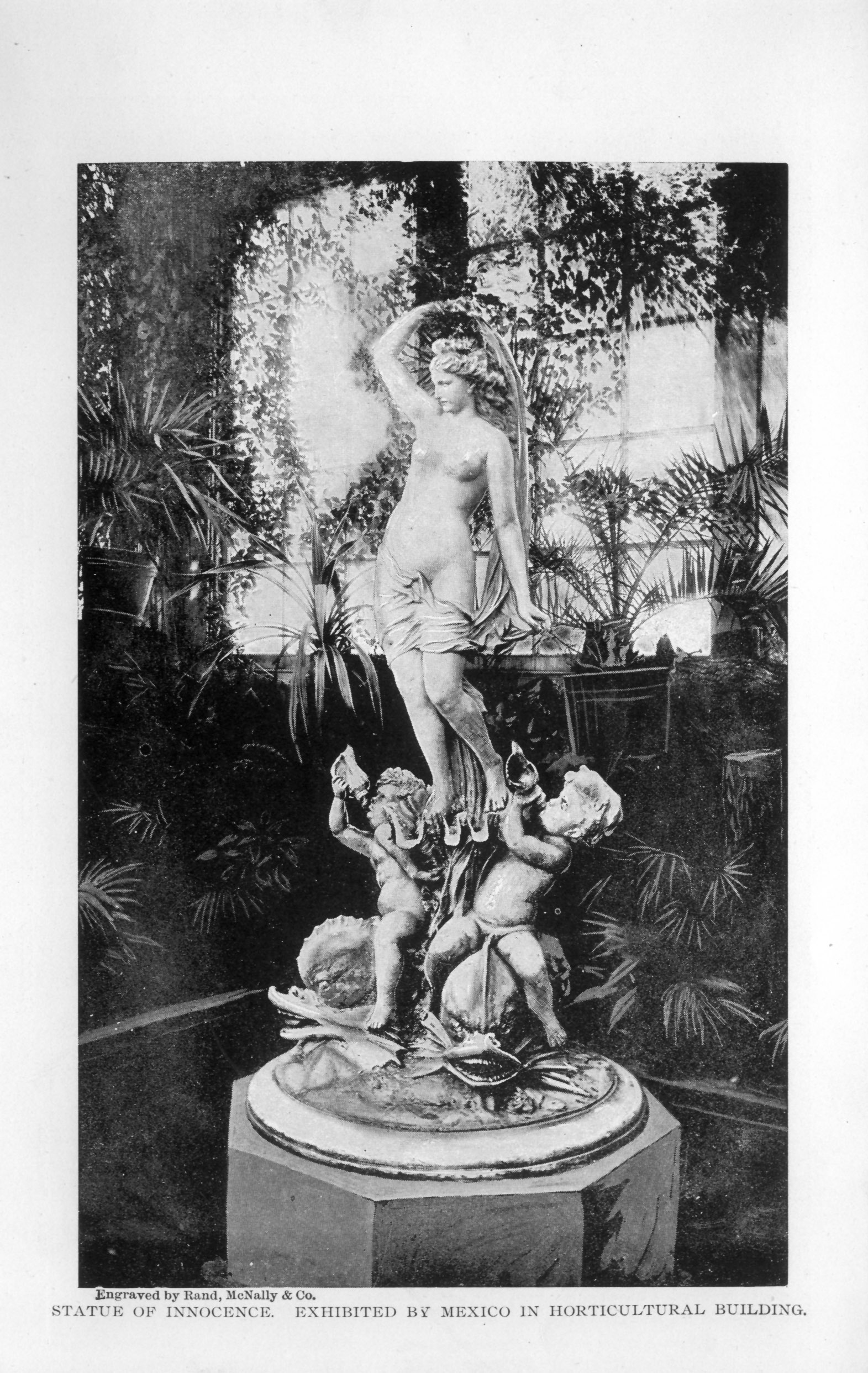
Engraved by Rand, McNally & Co.
STATUE OF INNOCENCE. EXHIBITED BY MEXICO IN HORTICULTURAL BUILDING.

Engraved by Rand, McNally & Co.
LOOKING NORTH FROM THE MINES AND MINING BUILDING.
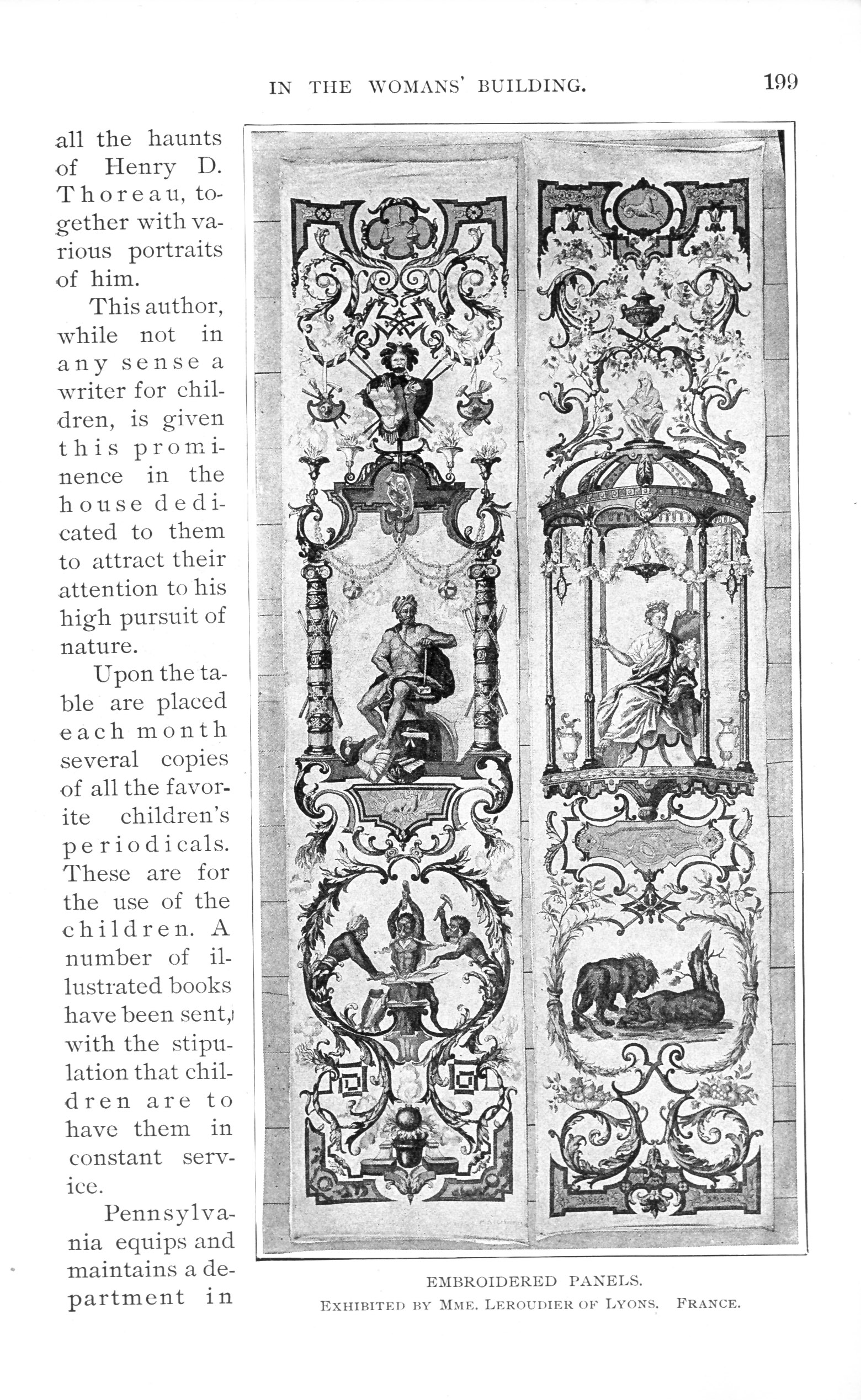
EMBROIDERED PANELS.
EXHIBITED BY MME. LEROUDIER OF LYONS. FRANCE.
all the haunts of Henry D. Thoreau, together with various portraits of him.
This author, while not in any sense a writer for children, is given this prominence in the house dedicated to them to attract their attention to his high pursuit of nature.
Upon the table are placed each month several copies of all the favorite children's periodicals. These are for the use of the children. A number of illustrated books have been sent, with the stipulation that children are to have them in constant service.
Pennsylvania equips and maintains a department in

FAIENCE.
HORTENSE RICHARD.
FRANCE.

the Children's Building, showing the wonderful progress that has been made in teaching very young deaf mutes to speak. Miss Mary Garrett, secretary of the Home for Teaching Deaf Mutes to Speak, is in charge of this department. Daily demonstrations are given.
There is a department of Public Comfort in connection with the Children's Building, intended especially for the benefit of children. One hundred infants and small children are received and placed in the care of competent nurses, who, for a small fee, provide for all their wants while their mothers are visiting the various departments of the Exposition.
For the amusement of visiting children there is a large playground on the roof; this is inclosed with a strong wire netting, so the children are perfectly safe. This playground is very attractive, ornamented with vines and flowers. Here, under cover, are exhibited toys of all nations, from the rude playthings of the Esquimau children to the wonderful toys which at once instruct and amuse. These toys are used to entertain the children.
The building has an assembly-room, containing rows of little chairs, and a platform from which stereopticon lectures are given to the older boys and girls, about foreign countries, their languages, manners, and customs, and important facts connected with their history. These talks are given by kindergarteners, who then take the groups of children to see the exhibits from the countries about which they have just heard. Mr. T.H. McAllister of New York has generously given the use of the most approved stereopticon for this purpose, and the services of an operator of the same during the entire Exposition. This audience-room is also available for musical, dramatic, and literary entertainments, which will be carefully planned to suit the intelligence of children of various ages.
The Children's Building has no appropriation from the Exposition authorities. The Board of Lady Managers has assumed the responsibility of raising the money necessary for its erection.
It has been at a great outlay of time and strength that the money for the Children's Building has been raised and judiciously expended, but no one of the many workers who have contributed these precious building materials, time, and strength have grudged the costly sacrifice they have made. We believe not only that the children who enjoy our building's hospitality will be benefited by our work, but that the children in every State of the Union, in every country of the world, will directly or indirectly profit by it, and in this happy result we shall find an ample reward for what we have done.
EMMA B. DUNLAP.